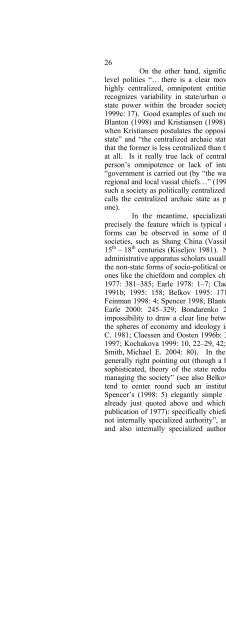Bondarenko Dmitri M. Homoarchy
Bondarenko Dmitri M. Homoarchy
Bondarenko Dmitri M. Homoarchy
You also want an ePaper? Increase the reach of your titles
YUMPU automatically turns print PDFs into web optimized ePapers that Google loves.
26<br />
On the other hand, significantly, in current research of the statelevel<br />
polities “… there is a clear movement away from a view of states as<br />
highly centralized, omnipotent entities toward a heterogeneous model that<br />
recognizes variability in state/urban organization and explores the limits of<br />
state power within the broader society” (Stein 1998: 10; see also McIntosh<br />
1999c: 17). Good examples of such movement have recently been provided by<br />
Blanton (1998) and Kristiansen (1998). However, it must be noted that, e.g.,<br />
when Kristiansen postulates the opposition between “the decentralized archaic<br />
state” and “the centralized archaic state” (1998: 46–48) 15 , he de facto means<br />
that the former is less centralized than the latter but not that it is not centralized<br />
at all. Is it really true lack of centralization (if it is not confused with one<br />
person’s omnipotence or lack of intermediary administrative levels) when<br />
“government is carried out (by “the warrior chiefs and king.” – D. B.) through<br />
regional and local vassal chiefs…” (1998: 46)?! 16 It would be better to describe<br />
such a society as politically centralized but disintegrated (and what Kristiansen<br />
calls the centralized archaic state as politically [more] centralized integrated<br />
one).<br />
In the meantime, specialization resulting in professionalization is<br />
precisely the feature which is typical of the state only, although its incipient<br />
forms can be observed in some of the most complex homoarchic prestate<br />
societies, such as Shang China (Vassiliev 1983) or the Hausa polities of the<br />
15 th – 18 th centuries (Kiseljov 1981). Not occasionally in specialization of the<br />
administrative apparatus scholars usually see the brink between the state and all<br />
the non-state forms of socio-political organization, again including homoarchic<br />
ones like the chiefdom and complex chiefdom (vide stricto Fried 1967; Wright<br />
1977: 381–385; Earle 1978: 1–7; Claessen 1987; Godiner 1991; Kochakova<br />
1991b; 1995: 158; Belkov 1995: 171–175; Kradin 1995: 44; Marcus and<br />
Feinman 1998: 4; Spencer 1998; Blanton et al. 1999: 112; Johnson, A. W. and<br />
Earle 2000: 245–329; <strong>Bondarenko</strong> 2001: 244–245), especially as far as<br />
impossibility to draw a clear line between the chiefdom and the early state in<br />
the spheres of economy and ideology is now generally recognized (Muller, J.-<br />
C. 1981; Claessen and Oosten 1996b: 365; 1996c: 20; Oosten 1996; Muller J.<br />
1997; Kochakova 1999: 10, 22–29, 42; Claessen 2000c: 182–186; Earle 2002;<br />
Smith, Michael E. 2004: 80). In the final analysis, Godiner (1991: 51) is<br />
generally right pointing out (though a bit too toughly) that any, even the most<br />
sophisticated, theory of the state reduces it to the “specialized institution of<br />
managing the society” (see also Belkov 1995: 171–175); at least, the theories<br />
tend to center round such an institution. So, I shall agree with Charles<br />
Spencer’s (1998: 5) elegantly simple dictum (the first part of which I have<br />
already just quoted above and which is based on Henry Wright’s seminal<br />
publication of 1977): specifically chiefdoms are “societies with centralized but<br />
not internally specialized authority”, and states are “societies with centralized<br />
and also internally specialized authority” (see also Earle 1987: 289). As







